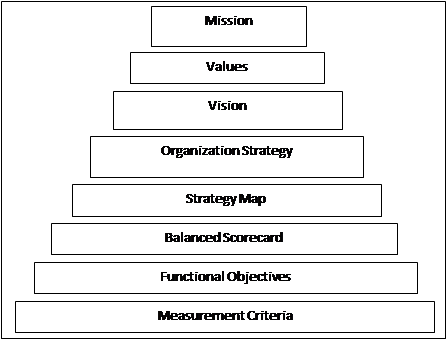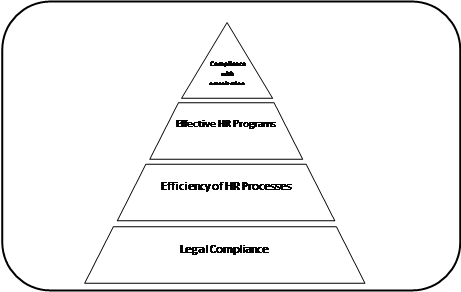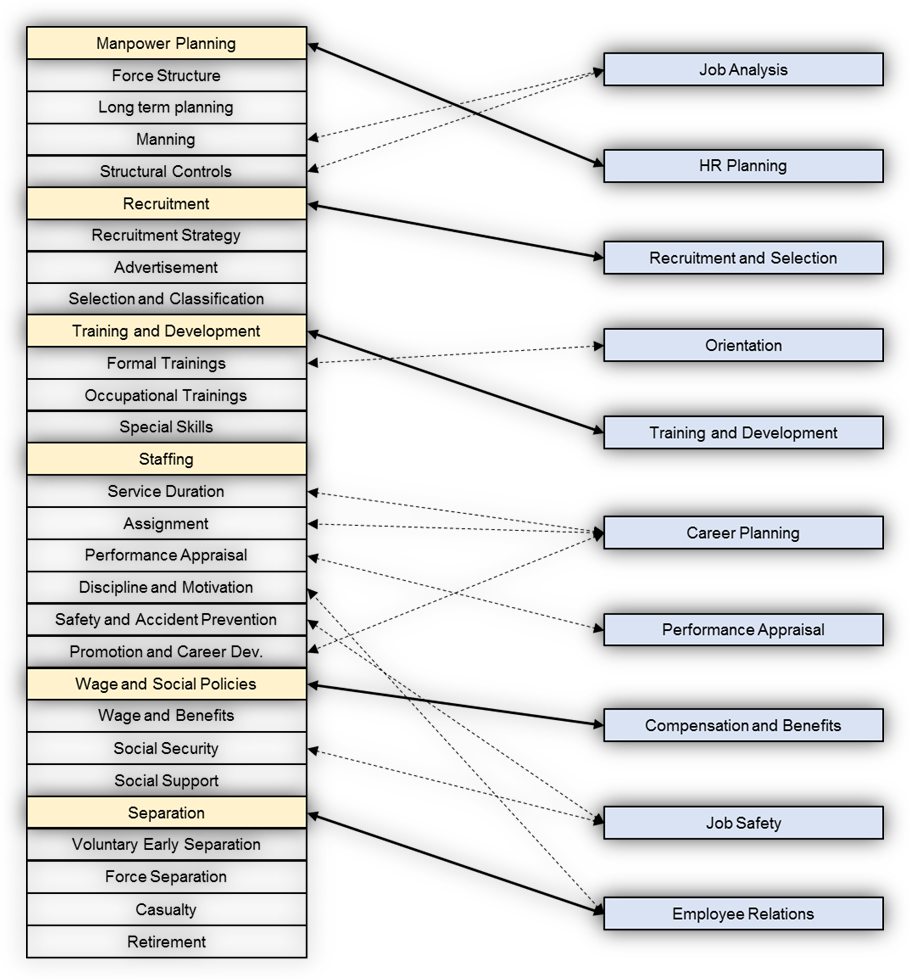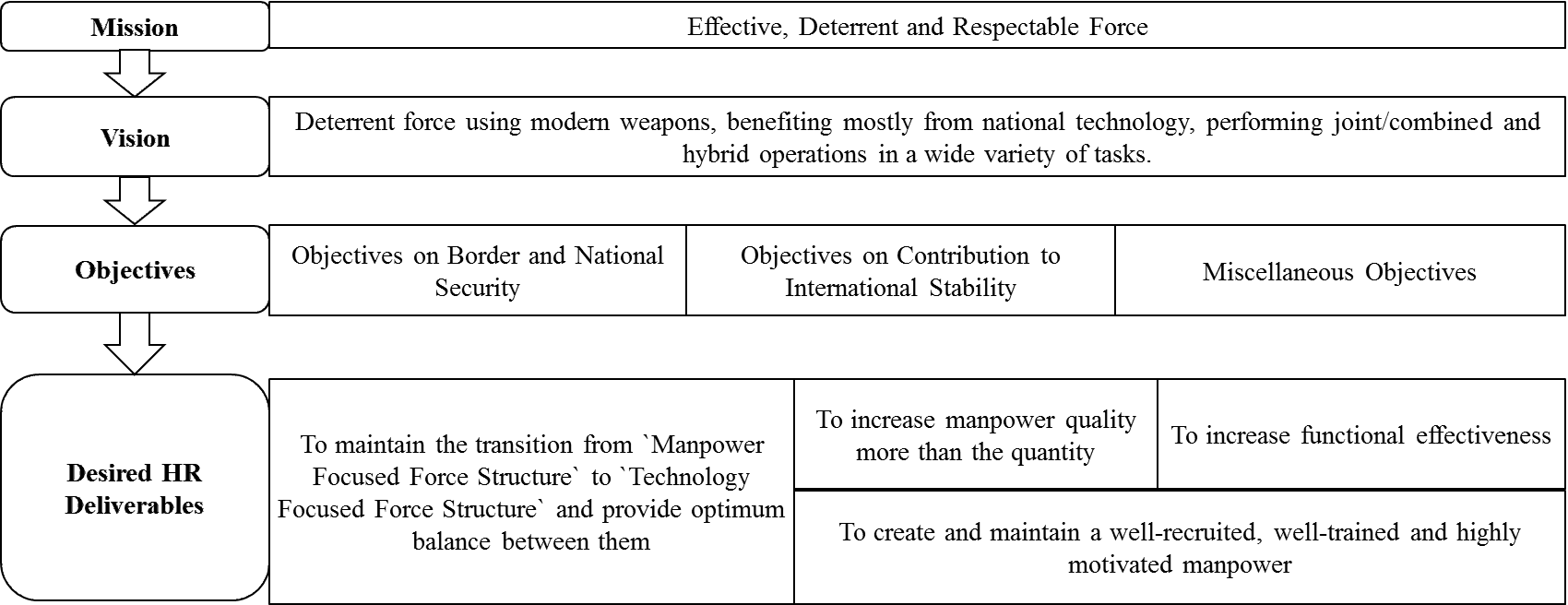Abstract
Increasing importance of strategy within the HRM literature required the systematic assessment of the relationship between organizational strategy and HRM, thus putting an immense impact in the measurement and evaluation studies on HRM. As a consequence of the focus shift in management literature, the classical measurement models have been partially abandoned, leaving the place to measure value-oriented HRM measurement models. One of the leading studies in the field is the study of Becker et al. (
Keywords: SHRMHR Scorecardbalance scorecardHR strategy mapHR deliverables
Introduction
HRM is directly associated with human capital of any organization. Similar to other types of measurements, measuring HRM has also been discussed from several different perspectives in a number of conceptual and empirical studies (Ulrich, 1997; Lengnick-Hall, Lengnick-Hall, Andrade, & Drake, 2009). Conceptual studies generally proposes three reasons for the necessity of measuring HR performance. In the first place, the measurement of HR effectiveness is seen as a necessity to measure ROI in human capital. (Becker, Huselid & Ulrich, 2001). Secondly, top managers believe that employees are important strategic assets for organization, however they do not know how to measure the effectiveness of this asset in terms of HR functions as well as how its` existence contributes to overall organizational performance (Becker et al., 2001). So far it has been stated by many scholars that the contribution of HR outcomes to organizational strategic goals should be measured (Brockbank, 1999). In general HR managers feel the necessity to prove how HR can contribute to organizational strategy and performance. Thus, they both help to increase the value of the HR by contributing significantly to the organizational performance, thus prevent the questioning of their existence across organization. Otherwise, it will become inevitable for them to face with HRM outsourcing.
The need for HRM measurement is not solely based on convincing top managers. Regularly every organization makes measurements on tangible assets (capital, machine, facility etc.), yet it has problems with measuring intangible assets such as management credibility, quality of organization strategy, creativity, innovation, ability to attract talented manpower, leadership etc. Though accounting specialists have achieved considerable success in the measurement of tangible assets, when it comes to measuring intangible assets, they generally prefer to focus only on accounting aspect not in other areas. This aspect leads them to consider HRM as a cost element which needs to be reduced constantly rather than evaluating as a value creating element. For this reason, HRM, by facilitating the measurement of intangible assets, is seen as an important leverage in creating organization-wise value creating effect as well as defining its position in industry and maintaining its organizational performance (Huselid, 1995; Sullivan, 2002; Schuler, 1992).
Importance of HRM functions and practices are increasing for all organizations as well as for the military context. To have qualified manpower in the ability to manage ever-changing defense technologies and be able to maintain, exercise and improve military power are must-to-obtain strategic military goals for achieving national security (Nuciari, 2006). In this respect the qualified manpower structure relies on founding the right HR architecture and the appropriate implementation of HR elements, employee behaviors and HR practices, and also constant follow-up of HRM performance. Just as it is for profit organizations, the military context also needs to follow its HRM performance.
Literature Review and Theoretical Framework
Methods and Approaches for HRM Measurement
A topic that has been engaging scholars since early 1920s has been related to how and what is measured in terms of HRM performance. Measurement efforts have concentrated both on classical and modern management theories (Tüzüner, 2014). The classical ones aiming more to achieve cost effectiveness for HRM and having dominated the field from 1920s up until 1980s include Human Resource Accounting (HR Accounting) Brummet, Flamholtz, & Pyle, 1968), HR Audit and Goals and Objectives Approach (Phillips & Seers, 1989). Value-oriented approaches based on organizational strategy has been at the forefront with the increasingly widespread use of strategic management (Miles & Snow, 1984; Jackson & Schuler, 2003). Among the modern studies are the HR ROI (Killian, 1976), Value Added Human Resources, Balanced Scorecard Method (Ulrich, 1997), HR Effectiveness Criteria Matrix (Greer, 2003), High Performance Business Systems (Becker & Huselid, 1998; Dessler, 2011), HR Scorecard (Becker et al., 2001). Specifically studies by Becker et al. (2001), Ulrich (1997), Mayo (2001), Phillips, Stone & Phillips, (2012) and Pauwe (2004) are highly valued.
Balance Scorecard Approach
One of the most cited work on HRM measurement literature is the `HR Scorecard` approach (Becker et al., 2001). This approach is constructed based on the Balance Scorecard (Kaplan & Norton, 1995) methodology which aims to measure organizational performance. Main principle of the Balance Scorecard method is that any organization must meet expectations of stakeholders (investors, customers and employees) to obtain competitive advantage. Primary assumption is that driving factor varies for stakeholders, so it is financial performance for investors, while it is quality satisfaction for customers and work environment for employees. Emerging in 1990s `Balanced Scorecard`, which still in use by many profit and non-profit organizations, takes into account non-financial indicators as well as financial ones. One reason for this method becoming so popular is that it proposes a measurement system integrated with the organization strategy specifically the strategic goals and objectives. In a study regarding the measurement and evaluation of organizational performance took into account the steps followed in the Balance Scorecard, and steps for the military organization were described as in Figure
While the source of mission in military context is generally stated as `Constitutional Tasks`, the vision is identified in National Security Strategy. One sub-element to National Security Strategy is the National Military Strategy describing organizational strategy on how national strategy is implemented by employing military force. Within this framework military concepts and doctrines are supplementary documents to identify how military strategy will be functionally supported. In general, concepts and doctrines are generally seen as the basis to create the strategy map for military. A concept is an idea, thought, or hypothesis that demonstrates how to achieve the goal specified in the vision. According to this, vision is the organization's future goal (dream) and concept puts forward the thoughts on how to achieve this goal in the short-middle-long term. On the other hand military doctrine sets the basic principles which, in achieving the goal, guides the use of the force. While doctrine itself is being binding, it also allows initiatives in military practices. For this reason main concepts (such as Personnel, Intelligence, Logistics, and Operation etc.) are regarded as the supportive sub-elements to create strategy maps for each functional area. While creating strategy map Balanced Scorecard is the final phase in which the measures are transformed into metrics.

HR Scorecard Approach
Similar to Kaplan and Norton (1995), Becker et al. (2001) suggested to measure each element of HR architecture (HR system, HR specialists and employees) while measuring the overall HR performance by keeping organizational goals, objectives and strategy in mind. As it directly concentrates on organizational strategy it differs from other measurement methods and results with different configurations for different types of organizations.
Becker et al. (2001) summarizes the measurement model as a seven-step process detailed below:
Defining organizational strategy,
Building a Business Case for HR as a Strategic Asset,
Creating a strategy map,
Identifying HR Deliverables within the strategy map,
Aligning the HR Architecture with HR Deliverables,
Designing the Strategic HR Measurement System,
Implementing Management by Measurement.
In this study, out of seven step only the first three were focused. Others can be used to create an HR Scorecard tailored for the needs of any organization. These three initial steps identify the road map to create HR Strategy map in any organization, so can be used as a guideline for any type of organization. In the first step, organizational strategy based on mission, vision and values bases is defined. At this stage it is useful to determine how the strategy will be implemented as well as what it is. It also explains what kind of activities the strategy will implement. Second step is a graphical design on how you plan to reach the desired objectives. The strategy map, formed by implementing a document analysis method, contains hypotheses and estimates about which organizational processes have a positive effect on the organizational performance. The validity of these hypotheses and estimates can only be achieved when they are exercised, that is to say when the strategy is implemented and the results are observed. The measurement system created can be made even more effective with available feedbacks. Third step is the most critical step of the proposed measurement model. At this step, the determination of which HR deliverables contribute to organizational strategy is evaluated and transformation of organizational goals/objectives into desired HR deliverables is finalized.
What is different for Military HRM?
Despite differences in many aspects compared to other organizational types, authority and responsibility of any military organization comes from the constitution and other military related acts. Responsibilities and authorities of other public organizations are usually regulated by couple acts, while they are carried out with significant number of acts in military organizations due to its nature. This fact reflects changes in the functions, practices and processes in management as well as all other sub-functions of management such as HRM. In a study focusing on public HRM, legal infrastructure is particularly emphasized and measurement of effectiveness of HR programs and processes are primarily described based on compliance with legal infrastructure (Gallo & Thompson, 2000). So it suggests to consider military related acts and laws as the basis to create strategy map for HRM.

Research Method
This study seeks an answer to the question of "How should a HR strategy map be designed in military context?”. HR Scorecard (Becker et al., 2001) is employed as the principle methodology. This method is developed based on the study of Balance Scorecard (Kaplan & Norton, 1995). In this respect creating HR Strategy Map in the military context requires the co-implementation of both methods.
In this study, the document analysis technique was used as the main analysis technique. This technique requires the examination of internal and external documents for the targeted phenomena to be investigated (Yıldırım & Şimşek, 2011). This technique allows researchers to reach the data they need without having to observe or interview. The question of which documents and data sources are important during the research is directly linked to the research question (Yıldırım & Şimşek, 2011; Gürbüz & Şahin, 2014). Focusing on documents that provide direct answers to the research question helps avoiding to examine unnecessary documents. While implementing this technique, company reports, marketing strategy, strategic plans, HR strategies, mission/vision definitions, accounting records, internal and external correspondence, official documents, written rules and directives within the organization, job descriptions can be used (Forster, 1994; Bowen, 2009).
Analysis Technique
While different scholars have different suggestions to implement this analysis technique, this study follows a configuration of 5-step approach introduced by Bailey (1982) as presented in Table-
Population and Sampling
To reach an answer to the research question Turkish military context was chosen to implement the study. Following higher hierarchy legislation (acts and regulations) which define mission, vision and objectives, lower regulations such as directives, concepts and doctrine in which the objectives are transformed into activities and processes were examined. Upper and lower legislation include key documents in determining HR deliverables which gives information on organization's mission, vision and goals. The combined use of upper and lower legislation in document analysis also made it possible to operate a systematic process proposed by Bowen (2009) and prevented unnecessary efforts.
Data Collection Process
During data collection process, Acts and Regulations related to the Turkish military context were collected through Turkish Legislation Management System (TLMS). This system includes collection of all types and series of legislation since country was founded in 1923. Following a query via the keywords on the internet page of TLMS, same process has been repeated over the local network and differences between both networks were identified. The keywords used in this inquiry included `Turkish Armed Forces (TAF) `. `Personnel`. `Mission`, `National Security Strategy`, `National Military Strategy` and `HRM`.
Findings
Findings on HRM Related Acts and Regulations
Table-
Findings on Military HRM Functions and Practices
Following a detail analysis on Military HRM acts and regulations, many differences on HRM practices between military and civilian organizations were found (see Figure-03). One of these difference is the `Job Analysis`which is seen as a separate function in civil organizations in general, and has not been directly expressed in the military context. The reason why military context does not include "Job Analysis" is that related practices in military context is in cooperated with another function which is called "Manpower Planning". The process of `Job Analysis` is carried out with the practices of "Manning" and "Structural Control" what is included in `Manpower Planning` function for the military context . In one hand "Manning" involves the establishment of the organizational structure, on the other it includes identification of the material and equipment of this structure. Outputs of `Job Analysis` such as defining job requirements and work environment is the output of `Manning` practice for military context. So, for an ideal `Manning`, `Structural Controls" process is repeated periodically, and required updates are accomplished accordingly similar to "Job Analysis" process in civilian organizations.
Except than above stated two practices "HR Planning" function in civilian organization contains considerably similar practices to "Manpower Planning" in military. On the other hand there is no significant difference between the function called `Personnel Recruitment and Selection` in military context and `Selection` in civilian except than couple specific practices.
`Orientation` which is mostly carried out as a separate function in civilian sector is part of "Training and Development" in the context of military organization. Formal trainings such as Military Academy, War College, NCO Academy etc. are expressed as part of the "Orientation" period by Nuciari (2006).
`Staffing` as a separate function in military includes different practices such as duration of service, assignment, performance appraisal, discipline and motivation, safety prevention, career planning, professional development and promotion practices. Compared to civilian HRM functions (Dessler, 2011), it can be easily seen that this function consists of several HR practices together. Though function includes multiple practices such as professional development, promotion, service duration together, all can be described under `Career Planning` function in any civilian organization. On the other hand, while "Discipline and motivation" in military context seems close to "Employee Relations" in content, "Safety and Accident Prevention" in military is also similar to "Employee Health and Safety".
"Wage and Social Policies" which is one of the main HR functions in the context of military organization can be evaluated together with "Compensation and Benefits" for civilian side. However, practices on "Social Security" and "Social Support" in this function are more related to "Employee Health and Safety" in civilian organizations. Also `Separation` is defined as a separate function in military while it is generally considered under `Employee Relations` in civilian.

Findings on Mission, Vision, Objectives and HRM Deliverables
"Effective, Deterrent and Respectable Military Force" is expressed as the mission statement for Turkish military context (TAF, 2018) which is the starting point on creating HRM strategic map (Cunningham & Kempling, 2008). The vision statement is based on the tasks and objectives that are given to the organization by laws, primarily the 35th article of Act on TAF Service (Nu: 211). Prior to defining the military HRM strategy map, it is necessary to set out the tasks, responsibilities and objectives associated with HR deliverables. As a result of analysis on the main and sub-legislation expressed in Table-
Based on document analysis results, in addition to above-stated main and sub-objectives, objectives on HRM (HR Deliverables) were found and presented as in Table-
The strategy map is a graphical illustration of the visualization process of the desired outcomes with a conceptual map. It describes the process of achieving the mission, vision and organizational objectives initially set. Considering results obtained in Table-

Conclusion and Discussions
Becker et al. (2001) refers to the "HR Strategy Map" as an essential tool in developing the HRM measurement model in any organization. They propose that identification of value creating HR practices is only possible by determining the HR outcomes that serve the organizational mission, vision and objectives, namely strategy map. For this reason, this research focused on the research question of `How should a strategy map be formed in the military context? ` The "Document Analysis Technique" was employed in five phase process and Turkish military context legislation (acts and regulations) were examined. Depending on the purpose of the study, "content" was selected as the unit of analysis and 21 legislations were examined. With the application of electronic search for selected keywords, related expressions to mission, vision and objectives were examined and "Military HR Strategy Map" presented in Figure-
Results indicated that military and civilian HRM functions are slightly different specifically in terms of practices and applications. Considering legislation as the principle guidance for military HRM foundation, many aspects of military HRM are organization specific. As organizational mission, vision and objectives are clearly stated in legislation, reaching to the Strategy Map was straightforward allowing periodic assessments and updates regularly. We suggest that HR strategy map is a useful tool for HR specialists to identify and create measurement model as well as scholars to investigate further on alternative ways for HRM Measurement. This map can be utilized effectively to create HRM Measurement Model for military context. Similar studies for other organizational contexts should be considered for comparison and improvement of proposed model.
References
- Bailey, K.D. (1982). Methods of social research (2nd ed.). New York: The Free Pres.
- Becker, B. E., Huselid, M. A. & Ulrich, D. (2001). The HR Scorecard: Linking people, strategy, and performance. Harvard Business Press.
- Becker, B. E. & Huselid, M. A. (1998). High performance work systems and firm performance: A synthesis of research and managerial implications. In Research in personnel and human resource management.
- Brockbank, W. (1999). If HR were really strategically proactive: Present and future directions in HR's contribution to competitive advantage. Human Resource Management, 38(4):337-352
- Brummet, R. L., Flamholtz, E. G. & Pyle, W. C. (1968). Human Resource measurement-A challenge for accountants. Accounting Review, 217-224.
- Bowen, G. A. (2009). Document analysis as a qualitative research method. Qualitative Research Journal, 9(2), 27-40.
- Nuciari, M. (2006). Handbook of the Sociology of the Military. G. Caforio (Ed.). New York: Springer.
- Cunningham, J.B. & Kempling ,J. (2008) Promoting Organizational Fit in Strategic HRM: Applying the HR Scorecard in Public Service Organizations. Public Personnel Management, 40(3): 193-213.
- Department of Defence (2005). The Army Strategic Planning Guidance 2006-2023. DoD. Retrieved from https://www.hsdl.org/?view&did=443218 (Last reached at: 01 April 2018)
- Dessler, G. (2011). Human resource management. Upper Saddle River, NJ: Pearson Education Inc.
- Forster , N. (1994). The analysis of company documentation. In C.Cassell and G. Symon (Eds.) Qualitative methods in organizational research: A pratical quide. London: Sage.
- Gallo, J. & Thompson, P. R. (2000). Goals, measures, and beyond: In search of accountability in federal HRM. Public Personnel Management, 29(2), 237-248.
- Greer, C. R. (2003). Strategic Human Resource Management. Boston, MA: Pearson Custom Pub.
- Gürbüz, S. & Şahin, F. (2014). Sosyal Bilimlerde Araştırma Yöntemleri. Ankara: Seçkin Yayıncılık.
- Hasan, A. (2013, July 13). 79 yıllık görev tanımı değişecek. Milliyet. Retrieved from http://www.milliyet.com.tr/79-yillik-gorev-tanimi-degisecek/gundem/detay/1736303/default.htm (Last Reached at:01 April 2018)
- Huselid, M. A. (1995). The impact of human resource management practices on turnover, productivity, and corporate financial performance. Academy of Management Journal, 38(3), 635-672.
- Jackson, S. E. & Schuler, R. S. (2003). Managing human resources through strategic partnerships. Nashwille: South-Western Pub.
- Kaplan,R.S. & Norton,D.P. (1995). Putting the balanced scorecard to work. Performance measurement, management, and appraisal sourcebook, 66.
- Killian, R. A. (1976). Human resource management: An ROI approach. Amacom.
- Lengnick-Hall, M. L., Lengnick-Hall, C. A., Andrade, L. S., & Drake, B. (2009). Strategic human resource management: The evolution of the field. Human Resource Management Review, 19(2), 64-85.
- Mayo, A. (2001). Human Value of the Enterprise. London: Nicholas Brealey Publishing.
- Miles, R. & Snow, C. (1984). Designing Strategic Human resource Systems. Organizational Dynamics. Summer: 36-52.
- Paauwe, J. (2004). HRM and performance: Achieving long-term viability. London: Oxford University Press on Demand.
- Phillips, J. & Seers, A. (1989). Twelve Ways to Evaluate HR Management. Personnel Administrator, 34(4), 54-58.
- Phillips, J. J., Stone, R. & Phillips, P. (2012). The Human Resources Scorecard. Routledge.
- Sullivan, J. (2002). HR metrics the world class way. Peterborough, NH: Kennedy Information.
- Schuler, R. S. (1992). Strategic human resources management: Linking the people with the strategic needs of the business. Organizational Dynamics, 21(1), 18-32.
- TAF (Turkish Armed Forces), (2018, April 01). Mission Statement. TAF. Retrieved from http://www.tsk.tr (Last Reached at:01 April 2018)
- Tüzüner, V.L. (2014). İnsan kaynakları yönetimi faaliyetlerinde ölçme ve değerlendirme. İstanbul: Beta Yayınları.
- Ulrich, D. (1997). Measuring human resources: an overview of practice and a prescription for results. Human Resource Management, 36(3), 303-320.
- Yıldırım, A. & Şimşek, H. (2011). Sosyal Bilimlerde Nitel Araştırma Yöntemleri. Ankara: Seçkin Yayıncılık, Sekizinci Baskı,
Copyright information

This work is licensed under a Creative Commons Attribution-NonCommercial-NoDerivatives 4.0 International License.
About this article
Publication Date
28 January 2019
Article Doi
eBook ISBN
978-1-80296-053-2
Publisher
Future Academy
Volume
54
Print ISBN (optional)
-
Edition Number
1st Edition
Pages
1-884
Subjects
Business, Innovation, Strategic management, Leadership, Technology, Sustainability
Cite this article as:
Genç, S., & Özcan, K. (2019). Developing An Hr Strategy Map For Military Context. In M. Özşahin, & T. Hıdırlar (Eds.), New Challenges in Leadership and Technology Management, vol 54. European Proceedings of Social and Behavioural Sciences (pp. 86-97). Future Academy. https://doi.org/10.15405/epsbs.2019.01.02.8
